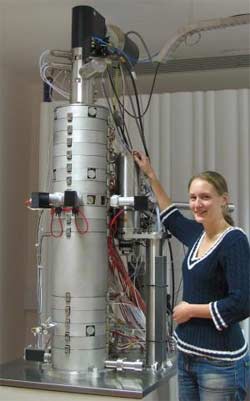A unique electron microscope, the first of its kind in the world, was unveiled recently at the STFC Daresbury Laboratory in Warrington. It will enable scientists to study atoms within materials in a way that has never before been possible and will pave the way for pioneering research relating to every aspect of our lives, from research into liver disease, to the creation of the mobile phones and computers of the future. Sponsored by the EPSRC and led by the University of Liverpool, the SuperSTEM 2 has been created by a collaboration of leading scientists from the universities of Liverpool, Glasgow and Leeds and the Daresbury Laboratory.
Atoms are the building blocks of matter and the study of these atoms is known as nanotechnology. The SuperSTEM 2 can show an atom at 20 million times its size. At 20 million times its size an atom would measure approximately 5mm across. To put this into context, if a person were magnified by this much they would be able to hug the Earth! However, it is not just the scale of magnification that makes SuperSTEM 2 unique -- it is also the sharpness of the image, its capability to provide elemental and chemical data about atoms and its stability. Built on sandstone bedrock, the incredibly stable geological conditions at the Daresbury Laboratory is one of the key reasons for its location -- the system is so stable that any sample in the microscope would move no more than half a millimetre in 100 years. In other words, 2000 times slower than continental drift.
The SuperSTEM 2, or Scanning Transmission Electron Microscope, works by scanning a beam that has been focussed down to the size of an atom, across a sample, providing chemical information on the sample at the same time. Although scanning transmission electron microscopy has been used as a technique for some years, detailed imaging of atoms was previously impossible due to defects that all lenses suffer from. SuperSTEM 2 is a great advance on traditional techniques as it has an inbuilt computer-controlled system corrects these defects, much in the same way that glasses correct the defects in people's eyes.
The SuperSTEM 2 is now being applied to a whole raft of projects, including medical research to achieve a deeper understanding of liver disease. It is also being used in the future development of mountain bike tyres and the next generation of computer chips in the quest to make smaller, yet more powerful, computers and mobile phones.

